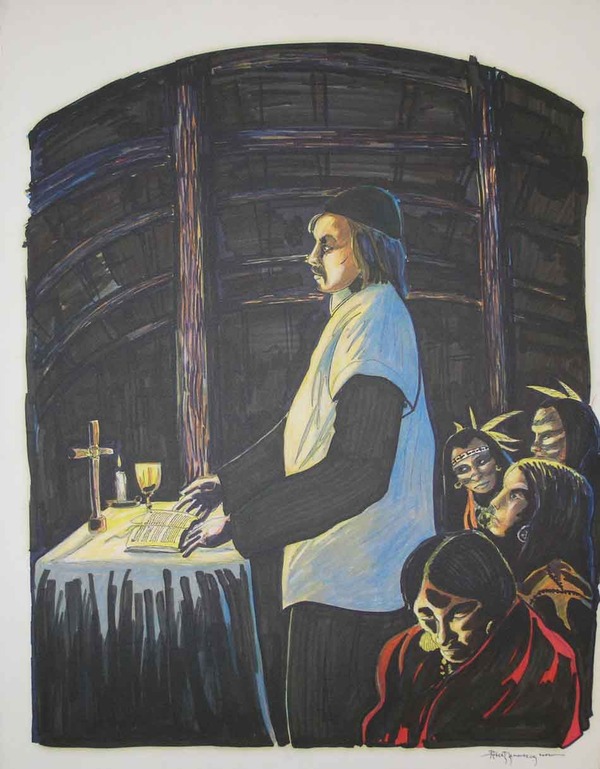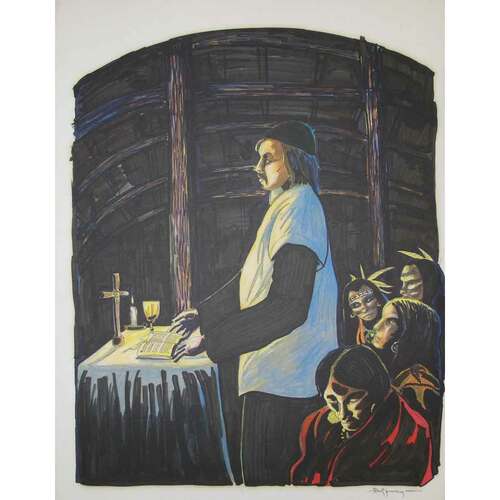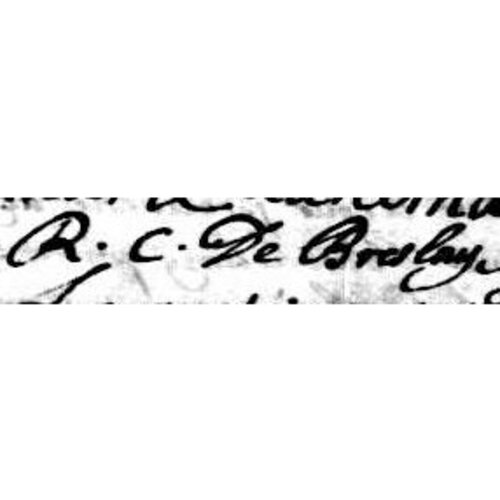
Source: Link
BRESLAY, RENÉ-CHARLES (Charles-René) DE, priest, Sulpician, missionary, vicar general of the bishopric of Quebec; b. June 1658 in Le Mans (Maine, France); d. in Paris 4 Dec. 1735.
After ten years as “gentleman in waiting of the privy chamber of the king,” Breslay entered the order of Saint-Sulpice, and was professed in 1689. He requested, and on 1 Feb. 1694 was granted, the opportunity of serving the church in New France. He arrived on 3 Aug. 1694 and was stationed in Montreal, first as curate (1694–96), then as parish priest of the church of Notre-Dame (1696–1703). Named parish priest of Sault-Saint-Louis at the extremity of Montreal Island in March 1703, he was instrumental in establishing on Îles de Vaudreuil a mission which centred on Île-aux-Tourtres. The mission was for the benefit of the Algonkins whose language Father Breslay had previously mastered and whom he had induced to move to this location.
His 16-year sojourn at Île-aux-Tourtres was marked by the establishment of a parish at Sainte-Anne-du-Bout-de-l’île; his disagreement with Governor Rigaud de Vaudreuil concerning the brandy trade, which Breslay opposed; his parochial duties at Pointe-Claire (1716–19); and his assistance towards the construction of a canal to bypass Sault-Saint-Louis (Lachine rapids), which had been initiated by Dollier de Casson.
Sparked by a desire to plead the cause of his missions and the church’s stand on the brandy question before the home authorities, Father Breslay returned to France (1719–20) where he encountered the Comte de Saint-Pierre who had been granted Île Saint Jean (P.E.I.) and neighbouring islands. At the invitation of the latter and with the eager concurrence of M. Lechassier, superior general of the Sulpician order, Father Breslay became the first parish priest on Île Saint Jean in April 1720. At this time, he was also made vicar general of the bishopric of Quebec. Aided by M. Métivier, he established a parish at Port-La-Joie (near present-day Charlottetown), where in 1722 was dedicated a church to St John the Evangelist. He also executed the manifold duties falling to him as missionary priest at Beaubassin (Chignecto) and other centres, especially Malpèque (Malpeque Bay, P.E.I.), which was frequented in the summer by the Micmacs. Lechassier had dreamed of establishing a seminary on Île Saint-Jean, but Father Breslay thought this premature and advised against it. To alleviate the financial burden of supporting parish priests, the Comte de Saint-Pierre suggested procuring representatives of a mendicant order for missionary work. To this end, Father Breslay returned to France on 29 April 1723.
Then followed a short stint as parish priest at Louisbourg (Île Royale), until in November 1724, at the request of the inhabitants, he was appointed to Annapolis Royal (formerly Port-Royal) where he was received officially by the council. Breslay was assigned a building at the extremity of the fort (known as Fort Mohawk), to be utilized as a parish house and a church. Of his welcome he wrote, “I had the honour to be received very graciously by Mr. Doucet [Doucett], the lieutenant-governor.” Later, however, Breslay received harsh treatment at the hands of Lieutenant-Governor Armstrong. In a letter to Governor Philipps*, Breslay claimed the lieutenant-governor had turned against him when he found himself unable to fulfil Armstrong’s request for a loan. By 1728, faced with the threat of imprisonment at the hands of Armstrong, Father Breslay was obliged to flee to a Micmac encampment where he remained for 14 months. He was reinstated in his parish after Philipps arrived at Annapolis Royal late in 1729. The next year Breslay went to Paris where he retired to a Sulpician seminary. He died there on 4 Dec. 1735.
Throughout his lifetime, Father Breslay adhered tenaciously to his religious ideals. Unfortunately, these brought him constantly into conflict with the civil authorities.
AN, Col., B, 27, 29, 33, 34, 35, 36, 37, 46, 47, 48, 53, 54, 55; C11A, 36, 37. “Correspondance de Vaudreuil,” APQ Rapport, 1938–39, 1939–40. PAC Report, 1905, II, pt.iii, 70–72, gives a transcript of Breslay’s letter to Governor Philipps. Allaire, Dictionnaire, III. Le Jeune, Dictionnaire. Tanguay, Répertoire du clergé. Brebner, New England’s outpost. Casgrain, Les Sulpiciens en Acadie. Henri Gauthier, La Compagnie de Saint-Sulpice au Canada (Montréal, 1912); Sulpitiana (Montréal, 1926). Harvey, French régime in P.E.I. J. C. MacMillan, The early history of the Catholic Church in Prince Edward Island (Quebec, 1905). Édouard Richard, Acadie, reconstitution d’un chapitre perdu de l’hîstoire d’Amérique, éd. M.-J.-H. Beaudé [Henri d’Arles] (3v., Québec and Boston, 1916–21), I. Pierre Rousseau, Saint-Sulpice et les missions catholiques (Montréal, 1930), 112, 123, 132–34. A. B. Warburton, A history of Prince Edward Island from its discovery in 1534 until the departure of Lieutenant-Governor Ready in A. D. 1831 (Saint John, N.B., 1923). Olivier Maurault, “L’île aux Tourtes,” in Marges d’histoire (3v., Montréal, 1929–30), III, 155–64.
Cite This Article
E. A. Chard, “BRESLAY, RENÉ-CHARLES (Charles-René) DE,” in Dictionary of Canadian Biography, vol. 2, University of Toronto/Université Laval, 2003–, accessed December 31, 2025, https://www.biographi.ca/en/bio/breslay_rene_charles_de_2E.html.
The citation above shows the format for footnotes and endnotes according to the Chicago manual of style (16th edition). Information to be used in other citation formats:
| Permalink: | https://www.biographi.ca/en/bio/breslay_rene_charles_de_2E.html |
| Author of Article: | E. A. Chard |
| Title of Article: | BRESLAY, RENÉ-CHARLES (Charles-René) DE |
| Publication Name: | Dictionary of Canadian Biography, vol. 2 |
| Publisher: | University of Toronto/Université Laval |
| Year of publication: | 1969 |
| Year of revision: | 1982 |
| Access Date: | December 31, 2025 |




